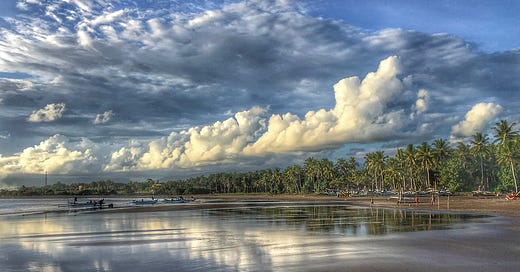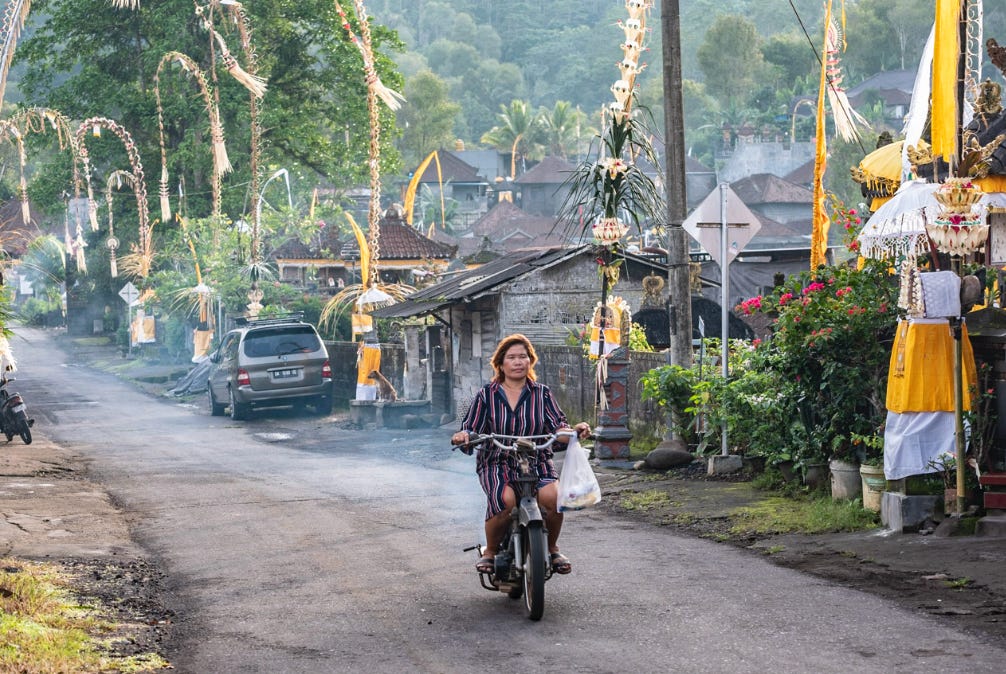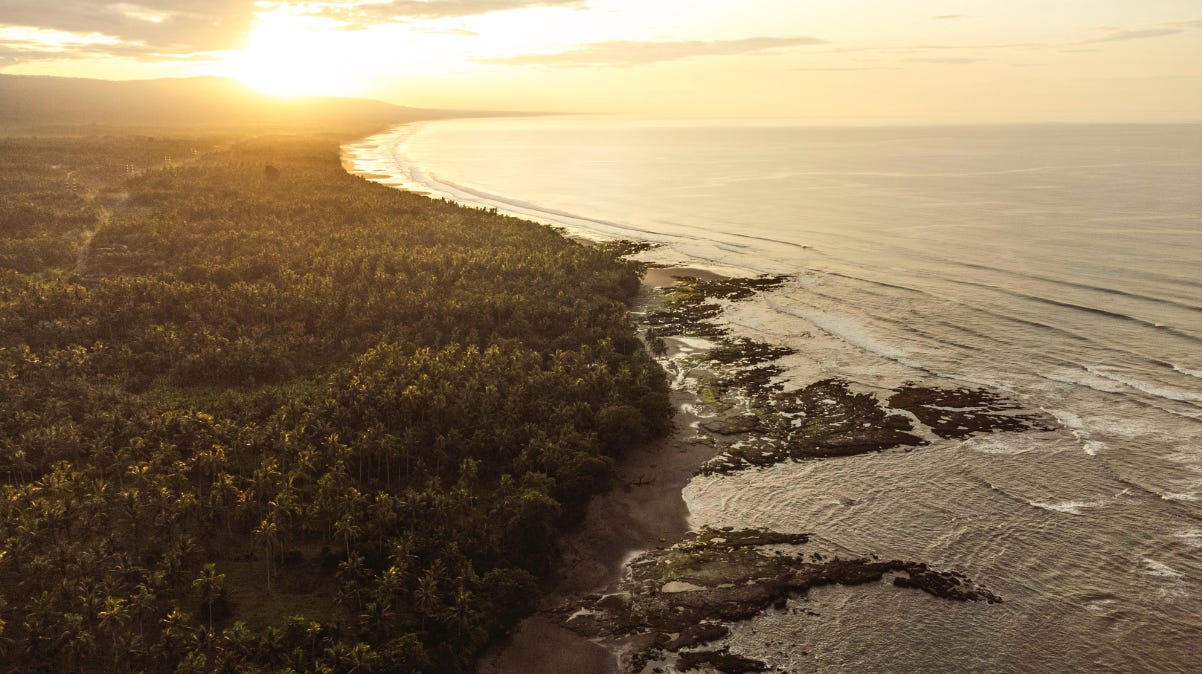'I Could Live Ten Lifetimes on the Island and Still Learn Something'
Narina Exelby on conscious consumption, sacred trees, and togetherness in Bali
Hi, friends! I’m currently roadtripping through the Balkans. As I attempt to unplug, I may be less present in the comment section than usual.
I’ll be sending paid subscribers dispatches from the road over the next couple of weeks—please upgrade here if you’d like to follow along—but for today, I hope you enjoy this Wanderlust Salon, a monthly series where we meet up with a guest to explore a corner of the globe that’s left a permanent mark on their heart.
“Indonesia has been home—in as much as a home can be to someone who’s almost constantly roaming—since around 2013,”
tells me.A travel writer since 1999, Narina’s work leads her to drift from place to place, but the Indonesian island of Bali is where she spends most of her time—and she quite literally wrote the book on it. Narina co-wrote Secret Bali: An Unusual Guide; she recently contributed chapters to Lonely Planet’s guide to Bali; and she dedicates a whole section of her newsletter,
, to exploring places beyond the tourist hotspots of Ubud and Canggu.From the shade of a sacred tree on the west side of the island, Narina writes: “[u]p here, on the volcanic hills that climb back from the island’s coastline, a gentle mist fades the branches into cloud; at times it swirls and lifts, revealing a tree that seems to go on forever, and then the cloud drops, closing in on the magnificence of this place.” (Did that give you goosebumps, too?)
Of all the compelling and offbeat places Narina has been to and written about (like the frigid mountaintops of Lesotho), it’s evident Bali is the one that stole her heart. She learned to speak Indonesian by listening carefully to locals’ conversations. She’s managed to garner a very basic understanding of Bali’s multiple calendars (no small feat, as they are incredibly complex), and she even wrote a cookbook with a Balinese friend. “It’s been a privilege and an incredibly beautiful gift, to be welcomed and accepted and absorbed into their life,” Narina says.
There’s no doubt that Narina’s active participation in her local community is testament to the openness and warmth of the Balinese. But it is also the product of Narina’s own tenacity, humility, and curiosity. When sticking to the confines of the expat spaces that pepper the island would have been the easy thing to do, Narina instead chose to assimilate. She approaches life in Bali by playing a net-positive role in the existing ecosystem rather than treating the island as a playground.
We should all take notes. As you’ll see in the interview below, Narina is an exemplar of how we travelers and wanderers can be good stewards of a world that is increasingly small, crowded, and commodified: by making an effort to be good neighbors to those we meet along the way; by doing what we can to support locally-owned businesses; and by being open to new knowledge and new connections.
“I always say that as a foreigner I could live 10 lifetimes on the island and still learn something new about the Balinese culture every day,” Narina says. I think the same can be true of anywhere—but only if we remember to stay as curious as she is.
Read on for more of Narina’s life amid the fishing villages and sacred forests of Bali.
Thank you so much for being here, Narina! Tell us about your personal connection to Indonesia—how much time have you spent in the country, and what brought you there?
Indonesia has been home—in as much as a home can be to someone who’s almost constantly roaming—since around 2013. It was an organic transition, not a deliberate decision to Put Roots Down. My partner (Mark) and I are both travel writers and for about a year after he and I became ‘we’, we didn’t live anywhere in particular; we were picking up a lot of work around South East Asia, and found ourselves gravitating to Bali in between assignments. Over time we’ve ended up with a small, simple bamboo place that we call home. We’re almost always on the move for work; before the pandemic we might have spent a total of around six months a year on the island; lately it’s been only three, maybe four months a year.
What is your favorite thing about Bali? What makes it unique? Tell us about the sights, smells, and tastes!
The Balinese culture is incredibly complex—and absolutely fascinating. Traditions and religious beliefs are deeply rooted in everyday life, and I love that it’s absolutely normal to, say, walk into an office and meet someone who has a flower tucked behind their ear and grains of rice stuck on their forehead (placed there while praying), or to drive around with palm-leaf decorations hanging from your vehicle mirrors, because it was an auspicious day for motorised objects to be blessed. Almost every day there’s a ceremony for something (I wrote about the Balinese calendars and how auspicious days are determined, here) and I always say that as a foreigner I could live 10 lifetimes on the island and still learn something new about the Balinese culture every day.
Did you arrive in Bali with an existing community? If not, how have you built one?
About 22 years ago Mark visited Bali for the first time. He’d looked through Lonely Planet’s Bali guidebook and then headed straight for the area it didn’t cover: the (largely rural) western section of the island. It’s how Mark always travelled—which is quite ironic, seeing as lately we’ve both written a number of chapters for various Lonely Planet guides. Mark ended up living almost a year in West Bali with a Balinese family; he’d always stayed in close contact with them, so we naturally gravitated to their village and The Family, as we call them (because Balinese people don’t have surnames), is our community. Aside from two sons who work in other parts of the island, no one else spoke any English at the time and so I learned to speak Indonesian through listening to their conversations with Mark. It’s been a privilege and an incredibly beautiful gift, to be welcomed and accepted and absorbed into their life.
Bali has become known as an epicenter of overtourism. As someone in the travel industry, how has this affected you? What is your approach to it?
For more than a decade every time I’ve heard someone say “Bali is spoiled” I’ve known exactly where they’ve been—and where they haven’t. It’s a double-edged sword, really: I want to tell people about the parts of the island that are rarely visited, as I know so many small business owners who would benefit from more visitors—but at the same time I fear the changes that increasing tourist numbers will bring. So I’m very careful about the information I put out in the world, and the businesses I draw attention to. I choose to take on commissions that focus on culture and traditions (like this National Geographic piece about Balinese masks), and try to avoid ones that highlight the overcrowded areas. That said, I did write chapters on the busy areas for Lonely Planet’s latest Bali guide but whenever possible I mentioned small, locally owned businesses and hotels that really do care about operating ethically and responsibly. A few years ago Mark and I built WestBali.net to create some awareness of these places in the part of Bali that has yet to be marked by mass tourism. There is a Bali section on NE Where that highlights good reads about the island, gives insight into Balinese culture, and explores interesting places to go away from the crowds.
Have you felt any shifts in your mindset or your spirit since moving to Bali? How has life changed for you?
On a very practical level, I’ve made changes to what I consume and how I shop. In our area there is no rubbish collection; everyone must deal with their trash themselves. When you’re used to being able to recycle easily, and have other waste removed from your house regularly, and then suddenly all the trash you generate becomes your own responsibility, it’s impossible to turn a blind eye to what and how you consume.
Has living in Bali forced you to reexamine any of your cultural beliefs? What have you come to see differently since moving there?
I was raised in a non-religious family in apartheid-era South Africa. My father’s parents were English and my mum’s ancestors Scottish and, despite being an award-winning Highland dancer as a child (extremely low-key and hardly a claim to fame!), I’ve never considered I have a culture of my own. So it’s been an absolute delight and privilege to spend time in a place where culture, religion and traditions are so deeply rooted, and to witness life unfold to their rhythms.
What is something about Bali that those who haven’t been there might not expect?
This is far from exciting, but important for travellers planning an itinerary: don’t be fooled by distances. They might appear short, but it’ll likely take an age to travel. As an example, our home is 90 km from the airport, but it’ll take around four hours to drive—a combination of insane traffic congestion in the Seminyak and Canggu areas, and single-lane roads frequented by heavy trucks and buses.
What’s the craziest/funniest/most touching thing to have happened to you in Bali?
Many years ago we lived in the midst of a teensy fishing village in West Bali; only a narrow pathway separated our house from our surrounding neighbours. When Mark went away for a few days, the neighbours started to ask if I was okay sleeping at home alone. Did I want to stay with them, one neighbour offered, and people started to pop around to check in on me. It puzzled me at the time—so much attention!—but eventually I realised: it’s highly unusual for a Balinese person to ever live alone. Family and community is everything—and I was humbled when I realised why our neighbours were so concerned for me.
What are your favorite Indonesian foods and why? Are there any dishes that bring back special memories?
I love a simple nasi goreng, which is fried rice with a few vegetables, and often have this for breakfast (and lunch, and dinner). I try to resist the urge to smother it in kecap manis—sweet soy sauce—but if you’ve tried it you’ll know how addictive it is.
If I had 24 hours in Bali and travel time wasn’t a factor, how would you tell me to spend it?
I’d love for you to experience the authentic side of Bali, so prepare for a busy day! Get up super early and head to a village market. The one in Pekutatan, near where I stay, opens at 2am and closes around 7am—get there around 6am (grab a glass of sweet kopi, made from beans grown just up the hill) and you’ll be among women from the village who’re buying their fresh produce for the day. Just after sunrise take the road that leads from Pekutatan village through (yes, through) the sacred tree at Bunut Bulong and up over the hills to the north coast. The light at that time of morning is exquisite; you’ll drive along winding jungled roads, witness small villages just setting about their days, and you’ll see the silhouette of Batukaru volcano rising from rice paddies. Spend the morning snorkelling around Menjangan Island in West Bali National Park—the corals here are so colourful and marine life plentiful—then head to The Menjangan eco resort for brunch. Their Pantai restaurant is on a deck that juts into the bay, between the mangroves… you might even see Menjangan deer wading through the water. By late morning the colourful fishing boats might be offloading their catches at Perancak harbour—a real spectacle, as the boats operate in pairs and are beautifully decorated. The afternoon would be a brilliant time to walk in the sacred forest alongside Tamblingan, a caldera lake; the protected forest used to be an important source of medicinal plants, and the towering nettle and ficus trees here are just sublime. Late afternoon it’s back to your starting point near Pekutatan village to walk with Pak Sudana, a traditional rice farmer (and my Balinese ‘uncle’) who still uses buffalo to plough his paddies. He’ll take you along the beach with his buffaloes, and you’ll head into his beach-side paddies where he’ll explain the traditions and processes involved in farming rice. Hop on over to Ramput Siwi for sunset. It’s one of Bali’s important sea temples and, just like famous Uluwatu and Tanah Lot temples, it protects the island from evil forces from the sea. Apart from being a really beautiful clifftop temple, Ramput Siwi also has spectacular sunset views. Wrap up the day with dinner at Rasta Café in Medewi. My good friend Dewi is an exceptional cook (read about her here—we made a cookbook together during the pandemic) and her home-cooked Indonesian meals are the best I’ve ever had.
Thank you so much for joining, Narina!
What places and cultures are you continually learning about? Let Narina and I know what you think in the comments, and subscribe to Travel: NE Where for pieces that celebrate women who travel, insights on places that are off the usual, well-traveled routes, and more.
Thanks for reading—and see you for our next adventure,
Sam















I've been twice, most "recently" in 2015. It was magical. And there were places where tourists were few. As Narina hints, 75% of the tourism is on 25% of the island, so it's not hard to break away if you want to.
Thanks Samantha and Narina! How wonderful to hear about your life in West Bali Narina and know that it’s not all developers gone mad. I’m due for a visit and will def go for a reccie.